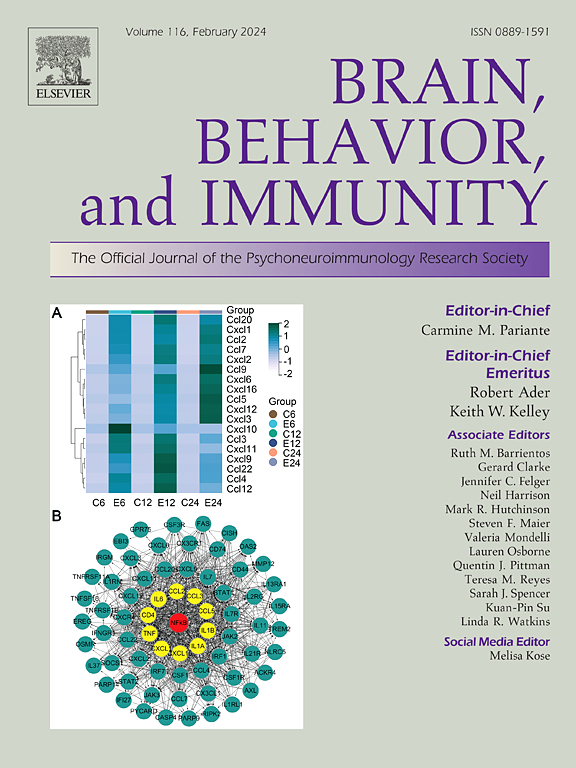健康大学生运动员的脑震荡史与精神症状、边缘系统结构和犬尿氨酸途径代谢物的关系
IF 8.8
2区 医学
Q1 IMMUNOLOGY
引用次数: 0
摘要
反复脑震荡患者通常会出现精神症状,但其潜在机制尚不清楚。将脑震荡与精神症状联系起来的一个潜在机制是炎症诱导的犬尿氨酸通路激活,该通路被认为在情绪障碍的发病机制中发挥作用。在此,我们调查了从社区招募的有不同脑震荡病史、身体健康的大学适龄男女运动员(N = 212)的脑震荡病史与多种精神疾病相关结果的关系。我们特别测试了以下假设:脑震荡史与精神症状加重、边缘系统结构异常(海马体积、使用神经元定向分散和密度成像评估的白质微结构;NODDI)以及犬尿氨酸途径(KP)代谢物(如喹啉酸;QuinA)升高有关。鉴于已知性别对脑震荡风险和恢复、精神疾病结果以及犬尿氨酸途径的影响,所有分析都考虑了性别的调节作用。在女性运动员中,脑震荡次数越多,抑郁、焦虑和失神症状越重(PS ≤ 0.005),而在男性运动员中,抑郁症状越重(P = 0.011)。在男女运动员中,脑震荡次数越多,双侧海马尾(ps < 0.010)和左侧海马体(ps < 0.001)体积越小。之前的脑震荡还与定向弥散指数(ODI)的升高和一些白质束(包括钩状束、齿状束、大镊和小镊)细胞内体积分数的降低有关,有证据表明在某些区域存在女性特异性关联。在血清 KP 代谢物方面,女性脑震荡次数越多,QuinA 水平越高,而男性色氨酸水平越低(ps ≤ 0.010)。最后,QuinA 的血清水平与 ODI 升高(男性和女性运动员)和焦虑症状恶化(仅女性)有关,而女性运动员的 ODI 升高和男性运动员的海马体积缩小与更严重的焦虑和抑郁症状有关(ps ≤ 0.05)。这些数据表明,累积性脑震荡与健康运动员的精神症状和边缘系统结构有关,女性运动员更容易受到这些影响。此外,这些结果与血清 KP 代谢物的关联突出表明,KP 是这些观察结果的潜在分子途径之一。本文章由计算机程序翻译,如有差异,请以英文原文为准。
Association of concussion history with psychiatric symptoms, limbic system structure, and kynurenine pathway metabolites in healthy, collegiate-aged athletes
Psychiatric outcomes are commonly observed in individuals with repeated concussions, though their underlying mechanism is unknown. One potential mechanism linking concussion with psychiatric symptoms is inflammation-induced activation of the kynurenine pathway, which is thought to play a role in the pathogenesis of mood disorders. Here, we investigated the association of prior concussion with multiple psychiatric-related outcomes in otherwise healthy male and female collegiate-aged athletes (N = 212) with varying histories of concussion recruited from the community. Specially, we tested the hypotheses that concussion history is associated with worse psychiatric symptoms, limbic system structural abnormalities (hippocampal volume, white matter microstructure assessed using neurite orientation dispersion and density imaging; NODDI), and elevations in kynurenine pathway (KP) metabolites (e.g., Quinolinic acid; QuinA). Given known sex-effects on concussion risk and recovery, psychiatric outcomes, and the kynurenine pathway, the moderating effect of sex was considered for all analyses. More concussions were associated with greater depression, anxiety, and anhedonia symptoms in female athletes (ps ≤ 0.005) and greater depression symptoms in male athletes (p = 0.011). More concussions were associated with smaller bilateral hippocampal tail (ps < 0.010) and left hippocampal body (p < 0.001) volumes across male and female athletes. Prior concussion was also associated with elevations in the orientation dispersion index (ODI) and lower intracellular volume fraction in several white matter tracts including the in uncinate fasciculus, cingulum-gyrus, and forceps major and minor, with evidence of female-specific associations in select regions. Regarding serum KP metabolites, more concussions were associated with elevated QuinA in females and lower tryptophan in males (ps ≤ 0.010). Finally, serum levels of QuinA were associated with elevated ODI (male and female athletes) and worse anxiety symptoms (females only), while higher ODI in female athletes and smaller hippocampal volumes in male athletes were associated with more severe anxiety and depression symptoms (ps ≤ 0.05). These data suggest that cumulative concussion is associated with psychiatric symptoms and limbic system structure in healthy athletes, with increased susceptibility to these effects in female athletes. Moreover, the associations of outcomes with serum KP metabolites highlight the KP as one potential molecular pathway underlying these observations.
求助全文
通过发布文献求助,成功后即可免费获取论文全文。
去求助
来源期刊
CiteScore
29.60
自引率
2.00%
发文量
290
审稿时长
28 days
期刊介绍:
Established in 1987, Brain, Behavior, and Immunity proudly serves as the official journal of the Psychoneuroimmunology Research Society (PNIRS). This pioneering journal is dedicated to publishing peer-reviewed basic, experimental, and clinical studies that explore the intricate interactions among behavioral, neural, endocrine, and immune systems in both humans and animals.
As an international and interdisciplinary platform, Brain, Behavior, and Immunity focuses on original research spanning neuroscience, immunology, integrative physiology, behavioral biology, psychiatry, psychology, and clinical medicine. The journal is inclusive of research conducted at various levels, including molecular, cellular, social, and whole organism perspectives. With a commitment to efficiency, the journal facilitates online submission and review, ensuring timely publication of experimental results. Manuscripts typically undergo peer review and are returned to authors within 30 days of submission. It's worth noting that Brain, Behavior, and Immunity, published eight times a year, does not impose submission fees or page charges, fostering an open and accessible platform for scientific discourse.

 求助内容:
求助内容: 应助结果提醒方式:
应助结果提醒方式:


